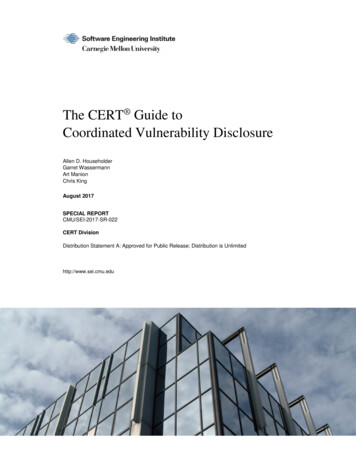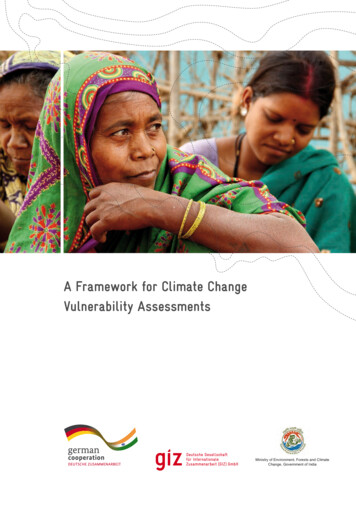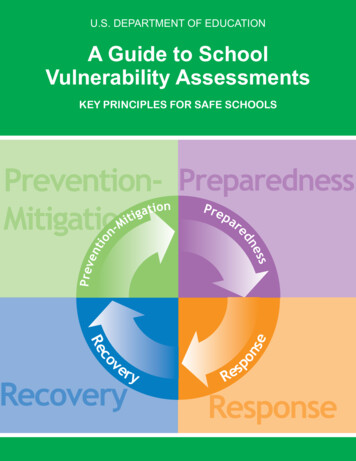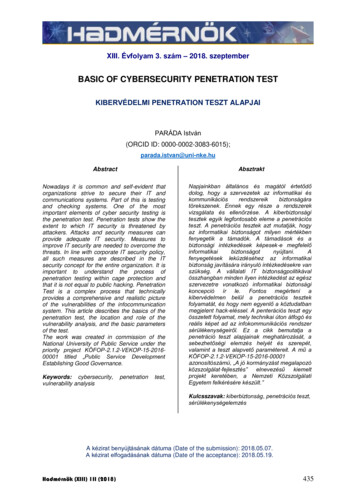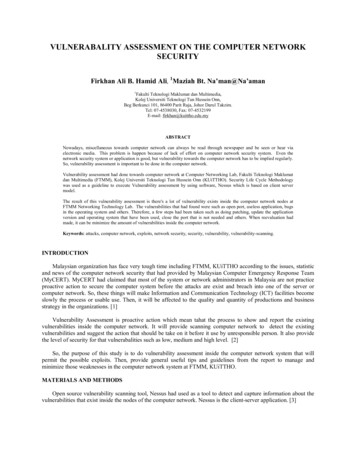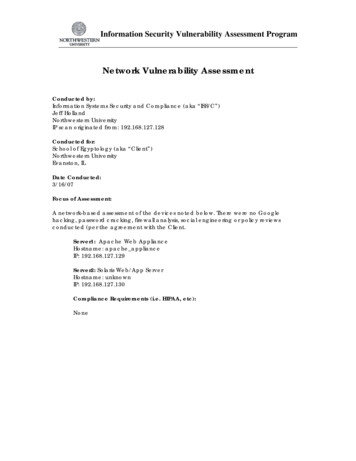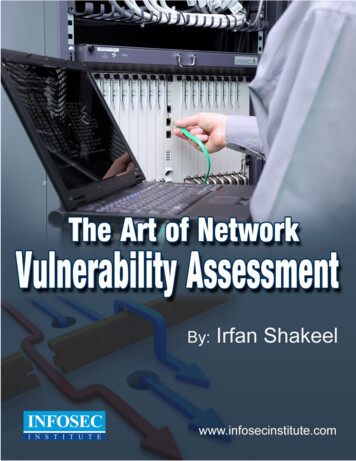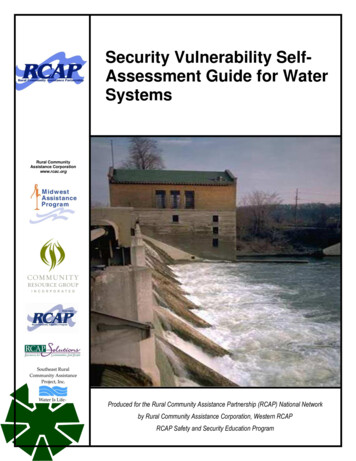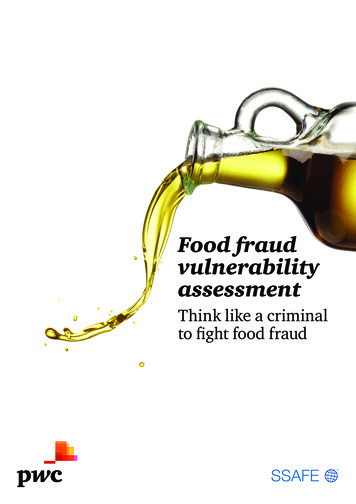
Transcription
Review ofVulnerabilityAssessmentMethods forReintegration andPrevention of ChildSeparation
Review of VulnerabilityAssessment Methods forReintegration and Preventionof Child SeparationAugust 2016Whitney Moret, FHI 360This publication was prepared by the FHI 360-managed ASPIRES project. Find out more about ASPIRESat engthening-aspires. For comments or queries regarding this publication, please contact us atASPIRES@fhi360.org.This report was produced under United States Agency for International Development (USAID) CooperativeAgreement No. AID-OAA-LA-13-00001. The contents are the responsibility of FHI 360 and do notnecessarily reflect the views of USAID or the United States Government.Review of Vulnerability Assessment Methods for Reintegration and Prevention of Child Separationi
EOVCUSAIDVATVCVIAdministration on Children, Youth and FamiliesAccelerating Strategies for Practical Innovation in Research and EconomicStrengtheningCommunity-Based OrganizationCore Program AreasCatholic Relief ServicesChild Status IndexCivil Society OrganizationCenter for the Study of Social PolicyDisplaced Children and Orphans FundDeinstitutionalization of Orphans and Vulnerable Children in UgandaEconomic StrengtheningFamily Status Vulnerability IndexHope and Homes for ChildrenHousehold Resiliency IndexHousehold Vulnerability Assessment ToolImproved Services for Vulnerable PopulationsNeeds Assessment ToolNational Commission for ChildrenNon-Governmental OrganizationPresident’s Emergency Program for AIDS ReliefPeople Living with HIVProgress out of Poverty IndexLIFT’s Provision, Protection, Promotion frameworkParticipatory Rural AppraisalSustainable, COmprehensive REsponses for Vulnerable Children and theirFamiliesOrphans and Vulnerable ChildrenUnited States Agency for International DevelopmentVulnerability Assessment ToolVulnerable ChildrenVulnerability IndexReview of Vulnerability Assessment Methods for Reintegration and Prevention of Child Separationii
TABLE OF CONTENTSAcronyms .iiIntroduction . 1Method . 2What We Know About the Concept of Vulnerability . 3Risk and Resilience Factors in the Context of Family-Child Separation . 4A Vulnerability Assessment Framework for Economic Strengthening . 8Assessment Methods Used in Programming Related to Unnecessary Family-ChildSeparation . 12Participatory targeting methods . 13Rapid Survey Tools to Classify Households and Monitor Change . 13Statistical Profiling of Separated Children to Identify Patterns and Geographic HotSpots . 14Using Government Data and Standards to Identify Beneficiary Households . 14Analysis of Tools . 16Criteria for Analyzing Vulnerability Assessment Tools . 16AVSI’s SCORE Project: Vulnerability Assessment Tool (VAT) and Needs AssessmentTool (NAT) . 17Global Communities’ Higa Ubeho Project: Household Resiliency Index (HRI) . 20Pact’s Yekokeb Berhan Project, ChildFund, and Retrak: Child Status Index. 21ChildFund’s DOVCU project: PRA and Family Status Vulnerability Index . 23Retrak: Community Assessments and Case Management Tools . 25Kids Alive’s Oasis Keeping Families Together: Basic Needs Assessment . 26Hope and Homes for Children: Risk and Protective Factors Assessment . 28Discussion . 29Conclusion and Recommendations for Future Research . 31Appendix 1. Summary of Tools, Category Cut-Offs, and ES Targeting Approaches. 33Appendix 2. Summary of Tools by Purpose and Notes on Validity Issues . 35Bibliography . 37Review of Vulnerability Assessment Methods for Reintegration and Prevention of Child Separationiii
INTRODUCTIONLike many social problems, the unnecessary separation of children fromtheir families is complex. Although practitioners working to preventseparation and reintegrate children into families have identified a number offactors that contribute to separation, no linear causal model exists, and thehousehold situations of those affected by separation can vary drastically.Economic strengthening, which refers to a body of microeconomicinterventions used to enhance household and community economicresilience, is of growing interest to actors concerned with family-childseparation due to the pervasive role of poverty in the dynamic ofseparation. These actors typically come from the world of child protectionand social work and identify limited experience and skills in economicanalysis and programming as a gap in their capacity to address family-childseparation (Kalyanpur & Chaffin 2014).While acknowledging that poverty plays a role in family-child separation, however, practitionersgenerally do not view poverty as the sole or decisive driver of family-child separation, andindeed the vast majority of children living in poor families do not separate from them. What arethe differences between families and children who are resilient to separation, and those who areparticularly vulnerable? How do economic security and insecurity contribute to family stabilityand family-child separation? The process of cost-effectively targeting the delivery ofinterventions depends on our understanding of vulnerability to separation, including the roles ofeconomic security and other drivers in contributing to family-child separation.Just as there is no linear causal model or standardized vulnerability metric for family separation,there is no standardized measure of economic vulnerability. However, donors and practitionersin this field agree that there is a need for a better understanding of vulnerability and astandardized set of metrics that can be used to target the delivery and measure the impact ofeconomic strengthening (ES) approaches and interventions on family separation (Mattingly2015, p. 18).Review of Vulnerability Assessment Methods for Reintegration and Prevention of Child Separation1
In this report, which has been prepared to inform planning in the USAID-funded ASPIRESproject, 1 we contribute to these efforts with a review of some of the existing tools used to assessvulnerability to either separation or negative child well-being outcomes with attention toeconomic security for the purposes of targeting households for program participation andmatching them to appropriate interventions. ASPIRES is sharing this report as an informationresource with the wider interested community given its relevance to other actors working in thisarea. The report begins with an overview of the concept of vulnerability, describing how it isused in the contexts of both child protection and economic strengthening programming. It goeson to propose a set of criteria for selecting and developing vulnerability measures for projecttargeting, drawing on existing standards of assessment in the fields of both child protection andeconomic strengthening. The report then discusses the vulnerability assessment approachesused by several organizations and programs working on issues related to child separation,followed by an analysis of the vulnerability assessment methods used according to theproposed evaluation criteria. It concludes with a discussion on the patterns identified in theanalysis, as well as recommendations for future assessments and suggestions for futureresearch on vulnerability assessment.METHODThis review seeks to better understand existing methods of assessing vulnerability in order toinform future interventions using ES as part of larger efforts to prevent child-family separationand promote integration of separated families. It was informed by reviews of the literaturepreviously conducted by the ASPIRES project, including a literature review on child-familyseparation (Laumann 2015) and a review of vulnerability assessment methods for ESinterventions (Moret 2014), as well as a scan of gray literature on child protection standards.This was followed by the selection of vulnerability assessment tools for critical review fromseven programs. Four of these programs have an explicit focus on reintegration and preventionof separation. Three programs do not have this focus but were included because they share acommon goal of reducing child vulnerability and improving well-being for those designated asorphans and vulnerable children (OVC) in a context of high HIV prevalence. The tools werereviewed and interviews were conducted with program staff to better understand how they wereused.The seven organizations and programs included in this review are concerned with providingservices to vulnerable children and use assessment tools for targeting services to households1ASPIRES is funded by USAID and PEPFAR and supports evidence-based, gender-sensitiveprogramming and learning to strengthen the economic capacities of vulnerable individuals, families andchildren. Under ASPIRES, a component supported by USAID’s Displaced Children and Orphans Fund(DCOF) aims to use rigorous evidence to inform the evidence base related to the ways in whichhousehold-level economic strengthening interventions can help prevent the unnecessary separation ofchildren from their families and reintegrate separated children in family care in low- and middle-incomecountries.Review of Vulnerability Assessment Methods for Reintegration and Prevention of Child Separation2
and individual children. They were selected based on suggestions from DCOF and availability ofsources of program information. They include the following, with more details available inAppendix 1:Table 1. Summary of Organizations and Programs ReviewedOrganizationChildFund andpartnersProject/ProgramDeinstitutionalization ofOrphans and VulnerableChildren in Uganda (DOVCU)Pact and partnersYekokeb BerhanRetrakRetrak ModelHope and Homesfor ChildrenACTIVE Family SupportmodelGlobalCommunities andpartnersHiga UbehoAVSI FoundationSustainable ComprehensiveResponses for VulnerableChildren and their families(SCORE)Oasis Keeping FamiliesTogetherKids AliveFocusDeinstitutionalization/reintegration ofchildren in familycare and preventionof family-childseparationReducingvulnerability of OVCReintegration ofstreet-connectedchildren in familycare and preventionof egration ofchildren in familycare and preventionof separationReducingvulnerability ofhouseholds withPLHIV and OVCReducingvulnerability of VChouseholdsCountry(ies)UgandaReintegration of childvictims of abuseGuatemalaEthiopiaKenya, Uganda,EthiopiaBelarus, Bosnia &Herzegovina, Bulgaria,Moldova, Romania,Rwanda, Sudan,UkraineRwandaUgandaWHAT WE KNOW ABOUT THE CONCEPT OF VULNERABILITYThe concept of vulnerability is used in a disparate array of disciplines, spanning frompsychology to engineering. It is generally understood as the likelihood of experiencing anegative outcome based on risks faced and capacity to respond to and overcome those risks.Measurement of vulnerability therefore requires measuring the likelihood of risk and capacitiesthat provide resilience. Risks include both sudden shocks and continuous stressors, and mayaffect large numbers or groups of people (covariate shocks) or individuals or households(idiosyncratic shocks). Risk measurement can be further broken down to both exposure to riskand sensitivity to risk, or how susceptible a unit is to the effects of a shock/adverse event(Woller 2011). Adaptive capacity or resilience can be understood, using the sustainableReview of Vulnerability Assessment Methods for Reintegration and Prevention of Child Separation3
livelihoods approach, as the assets that can help reduce sensitivity to risk and enhance thepursuit of sustainable livelihoods (Chambers & Conway 1991; Moser 1998). Note thatvulnerability is, by definition, a forward-looking, predictive concept that can be used to predictoutcomes based on identified risks (Moret 2014).Hoddinott and Quisumbing (2003) pose five questions that a vulnerability assessment shouldanswer: What is the extent of vulnerability?Who is vulnerable?What are the sources of vulnerability?How do households respond to shocks?What gaps exist between risks and risk management mechanisms? (p. 46)Answering these questions can be highly relevant to program design. Additionally, vulnerabilityassessment can be used to target and monitor interventions and measure impact. For thisreview, we focus specifically on the role of vulnerability assessments in targeting households forprogramming related to preventing family separation, including matching households toappropriate ES interventions.Risk and Resilience Factors in the Context of Family-Child SeparationAssessing vulnerability to family-child separation requires measuring both risks that contributeto the likelihood of separating and the assets that provide resilience against separation—alsoknown as protective factors. There are many pathways to family separation, and as of yet thereexists no standard, empirically-verified set of risks or protective factors to assess (Laumann2015). Because these factors may be highly context-specific, it is unlikely that any standardizedvulnerability measure will be relevant to all contexts. However, the literature on known risk andresilience factors related to family-child separation can provide insight for developing contextspecific measures.To assess vulnerability to separation, most programs reviewed draw on existing standards forassessing child protection and well-being. Since issues like abuse, neglect, and generally poorchild well-being are associated with risk for separation, these standards can provide a usefulstarting point for identifying context-specific risk and resilience factors in the context of familychild separation. The Interagency Guidelines for Case Management and Child Protection definevulnerability as the “physical, social, economic and environmental factors that increase thesusceptibility of a community or individuals to difficulties and hazards and that put them at riskas a result of loss, damage, insecurity, suffering and death” (Global Child Protection WorkingGroup 2014, p. 7). It advises the use of two stages to target for programming involving casemanagement for children who have been harmed or are at risk of harm. The first is theidentification of children most in need of this support. This can be conducted throughparticipatory exercises with community members, child protection committees, governmentagencies, self-referral, and other mechanisms. The next stage is assessment, includingReview of Vulnerability Assessment Methods for Reintegration and Prevention of Child Separation4
assessment of each child’s basic needs followed by a more comprehensive assessment at boththe household and child levels that includes the child’s development needs,parenting/caregiving capacity, economic factors, community and wider family influences, andsocial and cultural context (p. 56).In addition to these general guidelines, organizations may use indicators of risk identified overtime based on experience for prevention and reintegration programming. A robust set of driversof separation have already been identified by practitioner organizations (Laumann 2015). Manyof these line up with the literature on risk factors for abuse and neglect (Lamont & PriceRobertson 2013) as follows:Table 2. Indicators of RiskDrivers of Child Separation(Laumann 2015)Risk Factors for Abuse andNeglect(Lamont & Price-Robertson 2013)Family conflict or violenceViolence, abuse, neglect ofchild/children in household,conflict in householdPoor parent-child interactionUse of corporal punishmentLow warmth/harsh parenting styleCaregivers face challenges inmanaging children’s behaviorConflict and climate change, andnatural disastersHigh parental stressAbandonmentHistory of neglectChild in conflict with the lawInvolvement in criminal behaviorIncarcerated parentMore than three childrenLarge family sizeLow level of parental educationLow self-esteemElderly caregiverDeath of parent(s)Non-biological parent/s in the homeDisability of child or in householdParental disability(physical/cognitive/emotional)Parent abuse of drugs or alcoholParental substance abusePhysical health problemsReview of Vulnerability Assessment Methods for Reintegration and Prevention of Child Separation5
Illness/mental illness inhousehold, HIV/AIDSMental health problemsReconstituted household (e.g.,following divorce, remarriage/newpartnership)Separation/divorceSingle parent householdSingle parentUnwanted pregnancies, or/andpregnancy outside of marriage insettings where there isconsiderable stigma associatedwith thisTeenage/young parent(s)Additional indicators of increased risk of separation identified by organizations working onprevention and reintegration include: PovertyMigrant parent(s)No kinship support availableChildren lack access to education, education available is of poor qualityChildren are affected by harmful traditional practices/stigmaBeing engaged in harmful forms of workDeath of a childDeath of breadwinnerInadequate shelter/insecure housingThe lack of diversionary and non-custodial sentencing for children in contact with thelaw, which leads to children being placed in detention away from families (Delap 2013;Every Child 2009; as cited in Laumann 2015)In addition to the above risks that might “push” a child toward separation, “pull” factors can alsocontribute. Local care centers may actively recruit children, or the mere presence of nearbyinstitutions may exert a “pulling” effect that encourages separation. Other pull factors mightinclude work opportunities or the availability of education or other services away from home.It is likely that families that separate are driven to do so by multiple risk factors. In its Bosnia andHerzegovina program, Hope and Homes for Children noted that the children it servedexperienced between one and twelve risk factors, with the largest number of childrenexperiencing five to six risks (Sofovik et al. 2012).Review of Vulnerability Assessment Methods for Reintegration and Prevention of Child Separation6
In addition to risk, vulnerability assessments should account for sources of resilience. Severalorganizations interviewed for this review mentioned the importance of strength-basedapproaches to child protection programming, starting from the assessment phase (Retrak,AVSI, Hope and Homes for Children). Drawing from the child protection literature, the Center forthe Study of Social Policy (CSSP)’s Strengthening Families Approach to Protective Factorsidentifies the following protective factors against child abuse and maltreatment at the familylevel: Parental resilienceSocial connectionsKnowledge of parenting and child developmentConcrete support in times of needSocial-emotional competence of children (Child Welfare Information Gateway,Children's Bureau/ACYF, & United States of America 2014, p. 2)A recent symposium on reintegration and prevention of separation, hosted by CRS’s 4Childrenproject, identified the following resilience indicators that participants felt were supported byevidence: Access to educationAvailability of and access to material, psychosocial, childcare or other support from afriend or neighbor or within the community when needed to copeAvailability of kinship care/succession planningMental health/coping strategiesPositive parentingPerceived ability to care for disabilities and chronic illness (e.g. HIV)Sense of belonging and community acceptance (4Children 2015, p. 14)The possible combinations of key risks and protective factors contributing to separation areendless, and the tools used to assess vulnerability to family-child separation should begrounded in local context and include household-level and child-level information. In practice,programs and organizations working in the field have identified specific risk and protectivefactors affecting separation by reviewing case information related to separated or reunifiedchildren and their families (Hope and Homes for Children, EveryChild/Family for Every Child),participatory methods at the community level (an approach used in the ChildFund-led DOVCUproject in Uganda), and positive deviance inquiry to understand characteristics and behaviors offamilies in which separation did not occur, despite the presence of common risk factors. 2 Finally,it should be noted that there are instances where it is in the child’s best interest to be separatedfrom their family. Any assessment of vulnerability to separation should be focused on the2For more on positive deviance in the context of family-child separation, see: Durá, L., & Singhal, A.(2009). Utilizing a Positive Deviance Approach to Reduce Girls’ Trafficking in Indonesia Asset-basedCommunicative Acts That Make a Difference. Journal of Creative Communications, 4(1), 1-17.Review of Vulnerability Assessment Methods for Reintegration and Prevention of Child Separation7
contextually-appropriate understanding of when separation is unnecessary, or not in the child’sbest interest.A Vulnerability Assessment Framework for Economic StrengtheningThe term “economic strengthening” finds its origins in HIV/AIDS programming from the late1990s, where it was acknowledged that household economic status can have major effects onHIV outcomes, and that the effects of HIV significantly impact household economic stability andthe well-being of children (Markel & Gettliffe). Since then, ES has become a dedicated feature ofthe President’s Emergency Program for AIDS Relief (PEPFAR) programs for OVC, but ESprograms are not limited to contexts of high HIV prevalence. Broadly, ES programming involvesintegrating micro-level economic interventions into programs that address social problems, suchas family separation, where poverty is a contributing factor that must be addressed. In contrastto stand-alone poverty reduction interventions, ES interventions are often combined with otherinterventions, where poverty reduction is a means to achieve a programmatic goal.ES programming is focused on stabilizing or advancing a household’s economic situation toavoid downward spirals into poverty that can trigger negative economic coping practices. Theliterature shows that family-child separation is an example of a behavior used to cope witheconomic stress. Other negative coping practices may have negative effects on child well-beingthat lead to separation. For ES interventions to be effective in helping to prevent separation,they must be based on an understanding of the mechanisms by which economic status affectsvulnerability to separation.Vulnerability, or susceptibility to shocks, is an important feature of economic status. Measures ofvulnerability weigh the risks faced by an individual or household against their capacity to copewith those risks. Capacities to effectively respond to risk are usually measured in terms ofassets, which are the context-specific financial, social, physical, and other resources andcapacities a household can use to overcome shocks. Vulnerability is a useful construct in ESprogramming because, unlike poverty, which is usually a static measure, it is used to predict thefuture state of a household. Assessing the dynamics of vulnerability can provide insight on thekinds of interventions a household needs to prevent negative outcomes. There is no officialdefinition for vulnerability in ES or standard approach for measuring it. For the purposes of thisreport, we will define economic vulnerability in terms of susceptibility to responding to shocks byengaging in negative economic coping behaviors.Economic vulnerability assessments can be useful in the context of family-child separation bycontributing to an overall metric of vulnerability to separation as well as serving as a means formatching ES interventions to households according to household needs and capacities. Acommon framework for matching appropriate ES intervention types to economic status is theeconomic strengthening pathway model discussed in PEPFAR’s guidance for OVC projects(PEPFAR, 2012), which finds a close analogue in LIFT’s Provision, Protection, Promotion (PPP)framework (Woller 2011). The principal concept behind both frameworks is that interventionsshould be tailored according to household economic status, whether it is at the lowest level ofReview of Vulnerability Assessment Methods for Reintegration and Prevention of Child Separation8
economic security where cash and asset transfers are needed to promote stability, a middlecategory where interventions to smooth consumption are appropriate, or a more economicallysecure category where investments to grow household income are most likely to improveeconomic status. The capacity of households to obtain and use income and other assets ateach of these economic status levels is relevant to understanding the vulnerability of families toshocks, because assets protect households from negative coping behaviors during a shock(Chen & Dunn, 1996; Donahue, Kabbucho, & Osinde, 2001), including those that hurt child wellbeing. The PEPFAR categories, shown in Table 3 below, provide a useful starting point forcategorizing household vulnerability levels.Review of Vulnerability Assessment Methods for Reintegration and Prevention of Child Separation9
Table 3. PEPFAR Economic Strengthening Categories (PEPFAR 2012, p. 42).FAMILY SITUATIONS AND IMPLICATIONS FOR PROGRAMMINGFamilies in destitutionCharacteristicsResilience outcomesTrouble providing/paying for basic necessities (like food)Recover assets and stabilizehousehold consumptionNo discernible or predictable source of income butpotentially a lot of debt they cannot payVery few liquid assets (e.g., cash savings, livestock,food/crop stores, and personal belongings that could besold or traded for money)Probably classified as extremely food-insecurePurchasing power outcomes(Re)build short-term capacity to pay forbasic necessitiesEvidence-based strategiesConsumption supportTake care to understand whether this situation is chronic,transient, or acuteFamilies struggling to make ends meetCharacteristicsResilience outcomesUsually paying for basic needs (like food) but not regularlypaying for other needs (like school fees), especially if theyrequire lump-sum paymentsBuild self-insurance mechanismsand protect key assetsOne or more predictable sources of incomeSome liquid assets (as described above), which mayfluctuate throughout the year as they are accumulated andliquidatedSeasonal fluctuations in income/expenses, especially dueto agricultural calendar (i.e., they do well for one part ofthe year but poorly for another part of the year)Expand income and consumptionPurchasing power outcomesStrengthen family capacity to matchincome with expensesEvidence-based strategiesMoney managementFamilies prepared to growCharacteristicsResilience outcomesUsually paying for both basic needs (like food) and otherneeds (like schooling and basic health care) on a regularbasis; possibly struggling, but usually managing, to makelump-sum paymentsSmooth income and promote assetgrowthSmooth consumption and managecash flowSome liquid assets that fluctuate less throughout theyear than for struggling familiesPurchasing power outcomesSeasonal fluctuations in income/expenses, but probably notas dramatic as for struggling familiesGrow family income to enablemore/larger investmentsProbably classified as mildly food-insecureEvidence-based strategiesIncome promotionReview of Vulnerability Assessment Methods for Reintegration and Prevention of Child Separation10
While the table above shows groups of characteristics that PEPFAR associates with differentlevels of economic vulnerability, these levels are somewhat fluid and there is no formalguidance on how to make clear distinctions among these categories when classifying individualsand households. However, the logic of ES rests on the idea that target households need certainexternal assistance in order to enhance the assets that help them avoid engaging in negativeeconomic coping strategies. External assistance is only needed if households are unable toaccumulate enough assets for resilience on their own, implying that a set of barriers preventsthem from doing so, trapping them in poverty. One proposed framework for vulnerabilityassessment for ES involves identifying the asset threshold at which a poverty trap occurs.The identification of a threshold for a poverty trap can serve as an empirical basis fordetermining which households can be considered economically vulnerable to using negativecoping strategies
separation (Laumann 2015) and a review of vulnerability assessment methods for ES interventions (Moret 2014), as well as a scan of gray literature on child protection standards. This was followed by the selection of vulnerability assessment tools for critical review from seven programs.
